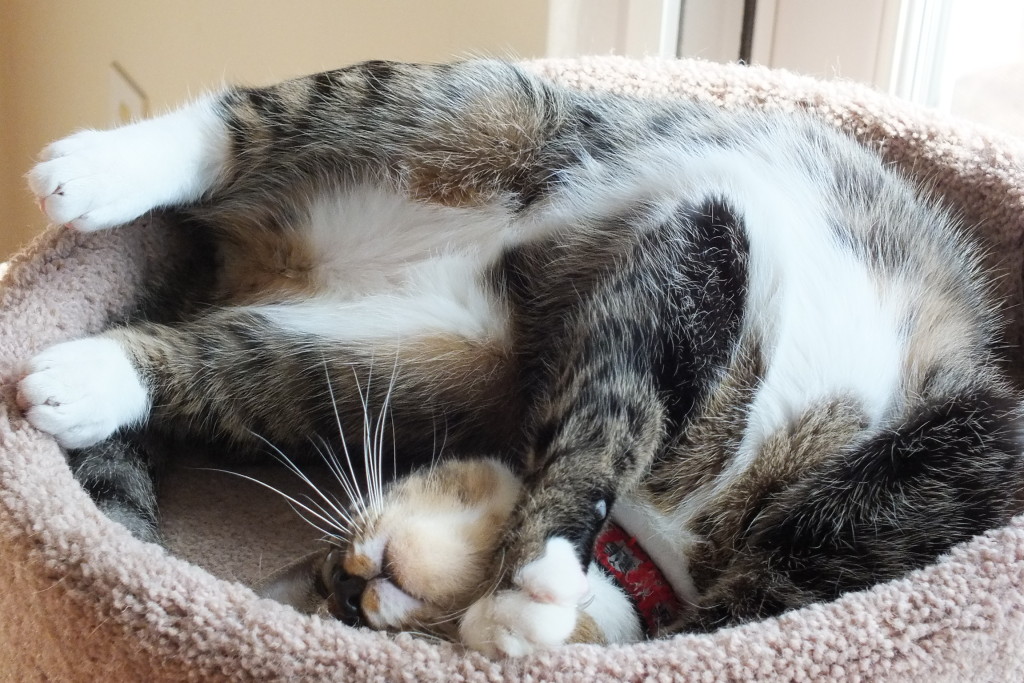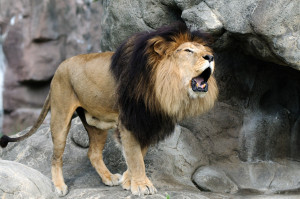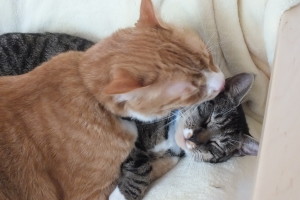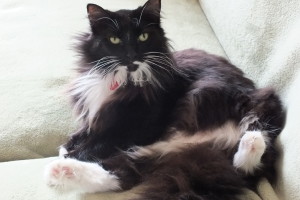Cut Purring As a Means For Healing Bones

Acoustic Healing and Purr Therapy
Whether your a cat person, a dog person, or a friend to other types of animals, you may soon come to appreciate the common household cat for something other than sitting in your lap and shedding. Researchers are conducting studies on cat purring as a method for healing bones, encouraging blood flow, the repair of muscles and encouraging tissue regeneration. Your trip to the doctor may some day include purr therapy.
Who Purrs?
All cats are in the family Felidae (Feel-a-day). Taxonomists, or the scientists that sort and organize animal family trees, sometimes sort the cat family by "purring" and "non-purring" or "roaring" and "non-roaring." I can only image the ways they had to try to get wild cats, like lions or bobcats to purr for their sorting! Anyway, eventually researchers came to the conclusion that almost all cats can purr, with the exception of the Pantherinae (big cats) such as lions, tigers, leopards, jaguars, snow leopards, and clouded leopards. Pantherinae cats can roar but they can't purr. Cheetahs, lynxes, domestic cats, and bobcats can purr but not roar.

Cheetahs are one of the few larger cats that can purr. Here's a fun short clip of a cheetah being petted and purring.
Why Can't Big Cats Purr?
Cat purring is made by the same type of vocal vibrations we use to talk, but it's more similar to the breathing that didgeridoo players use, because it happens on both the inhale and exhale of the cat's respiratory process. The muscles of a cat's larynx act to open and close the glottis, or the space between the vocal chords. When the glottis opens a space between the chords is created. As air passes over the chords it creates a vibration and the purring sound. The opening and closing of the glottis can occur on both the inhalation and exhalation of the cat's respiration, which is why their purr seems to be continuous, and not a funny purry-puncuated-hiccup. Here is a sound wave pattern and audio of a cheetah purring as it breathes in and out.
Big cats have an elastic ligament that connects the bones in their larynx. This bone gives their larynx enough flex so that they can create a roar but not enough flexibility to move back and forth to create a purr. Their roars can be so loud that they can be heard over many miles and physically hurt the human ear.
Here's a great short video (3:43) about how a cat purrs.
Why Do Cat's Purr?
So here's the deal...science is still pretty fuzzy about cat purring, why cats purr, and even how cats modulate their purr neurologically. Most people agree that cats purr when they are happy or relaxed. Kittens are exposed to contented purring of their mother, and in turn learn to purr when they are content. Some folks hypothesize that this type of purring, by the mother covers the kitten's mewling and protects them from predators. Alternatively, kittens can't drink and mewl at the same time, so it may be a way for kittens to signal to mom that they're doing OK, even though they are quiet.

Usually purring occurs between cats and their care takers as a signal of happiness or when food is impending. Researchers have shown that there are differences in purrs between cats that are interacting with other cats and when they interact with humans. Not all purring is happy purring though. Sometimes cats purr when they are nervous, injured, or when a larger and more aggressive cat is nearby.
Calling Dr. House Cat
There's little likelihood that you're going to go in for a cat scan and have someone hold a cat up and proclaim that you're healed. That isn't where this idea of cat-purr therapy comes from. It comes from real research into how cats heal themselves and at the same time how they conserve energy (let's face it, cats are great at this).
When a cat purrs, its purr frequency is almost exactly within the harmonic range of 25-250 Hertz (Hz). In house cats this is exactly at 26 Hz. These purr frequencies correspond exactly with frequencies that scientists use for electrical/vibrational therapies to treat broken bones, edema, joint problems, and wounds. Frequencies in this range are shown to promote tissue regeneration. How exactly does this work? Try to remember back to your studies of muscles and bones. When the body is exposed to high intensity pressure and strength training, bones and muscles become stronger, reinforcing themselves and adding muscle. Now imagine if you could take away the high impact and activity required for this reinforcement. Vibrational therapy creates this same healing and reinforcement using low frequency vibrations. And, for you musician types, purring is said to be in the key of D, which is a soothing key for humans as well (songs like "Blowin' in the Wind or Tom Petty's "Free Fallin'" are both in D).

Here are a few examples of studies on cats and their vibrational frequencies. In one case researchers applied 35 Hz vibrations to human hips and the lumbar spine to determine the efficacy of transmitting vibrations through humans that were standing. They found that these signals travel well through muscle, such that they can reach clear through to the bone. This means that such stimulation may effectively be used to stimulate bone growth and fighting osteoporosis. In another study researchers focused on the harmonics of the purrs of cheetah, ocelots, pumas, domestic cats, and servals. They found that the frequencies that they purred at were exactly those found to promote bone growth and healing. It's thought that they use this frequency to keep bones and muscles healing and recovering even when the cats were sedentary, to minimize energy use and maximize healing.
If scientists were able to mimic the purring of cats, and mechanically stimulate bones and muscles, even when a person was at rest, then the sound/vibrations could help induce bone growth, mitigate osteoporosis, and help with muscle loss/atrophy in elderly patients or even astronauts in space who face bone density and muscle loss due to weightlessness.Here is an article from NASA that found using short periods of time on vibrational plates helped prevent bone loss. Their research was also promising for post-menopausal women and preventing bone loss here on Earth too.
There are many patents pending for purring devices such as purr pillows. There is also one called the "Purr-like Vibration Device", which is meant to be used in therapeutic setting such as physical therapy or doctors offices.

Additionally, cat purr frequency has been shown to be calming and soothing. The sound has been shown to lower stress and petting a cat can lower blood pressure. Regardless of whether you like domestic cats or not, their purring may be coming to a doctor's office, psychologist, or physical therapist's office soon. This is yet another fascinating way that we can use biomimicry, or the ability of plants and animals to solve their problems as a way to approach our own problems. Going to nature as a teacher offers so many options!
Just for fun, here is my favorite free online cat purr maker, called "Furry Friend." It can be used on your desktop or as an app. You can set your own modulations for a continuous cat purr, from the sub base all the way to the high treble. It's something fun to just leave on as background noise (who knows perhaps for healing?).



